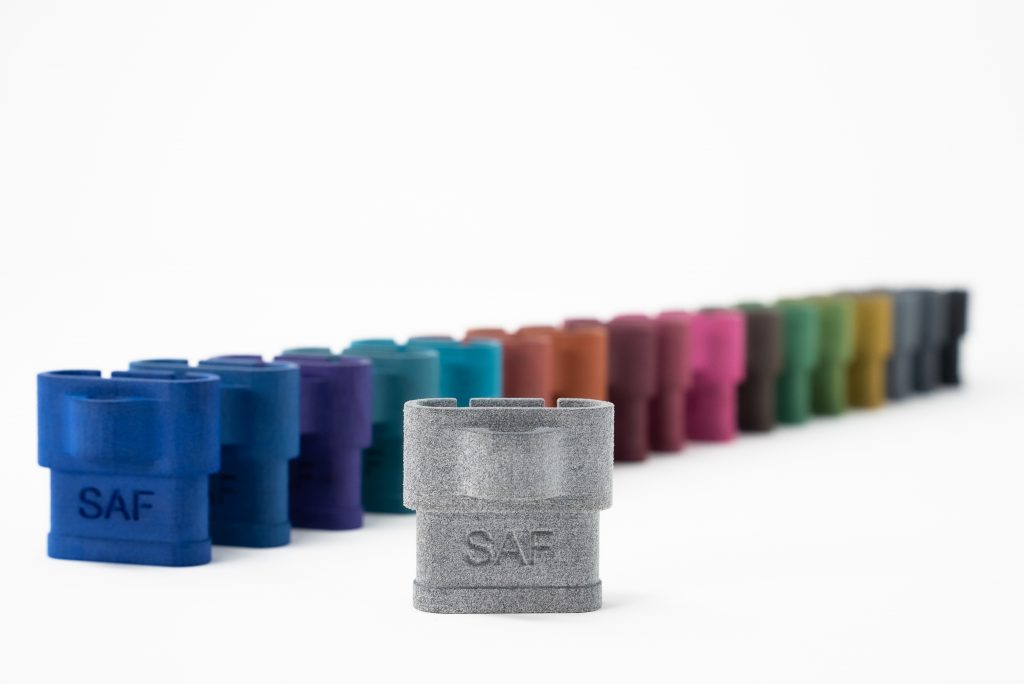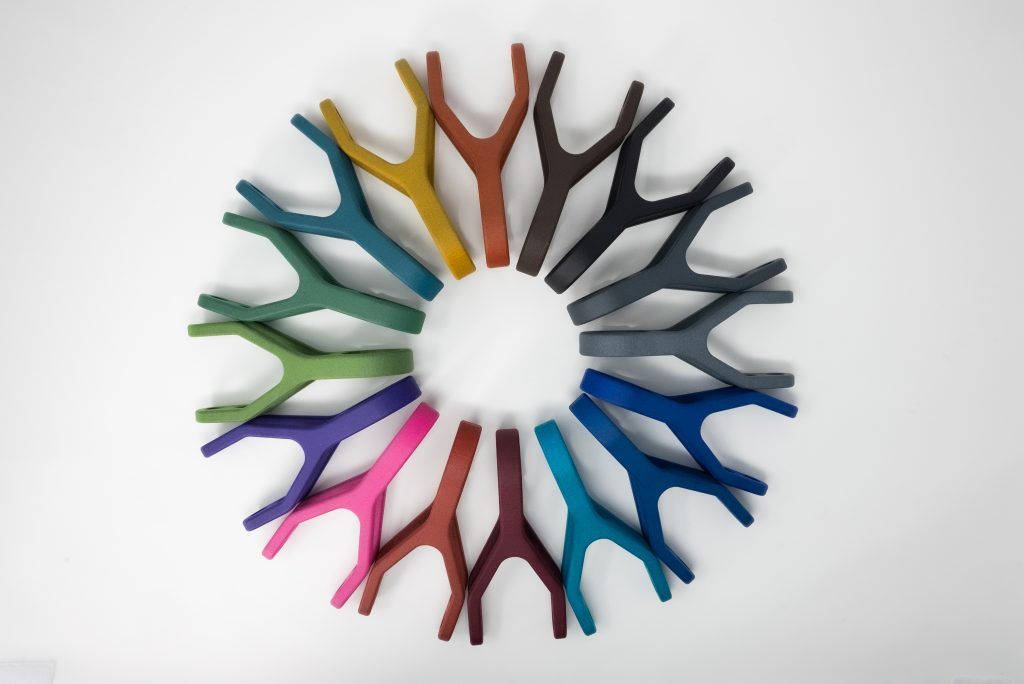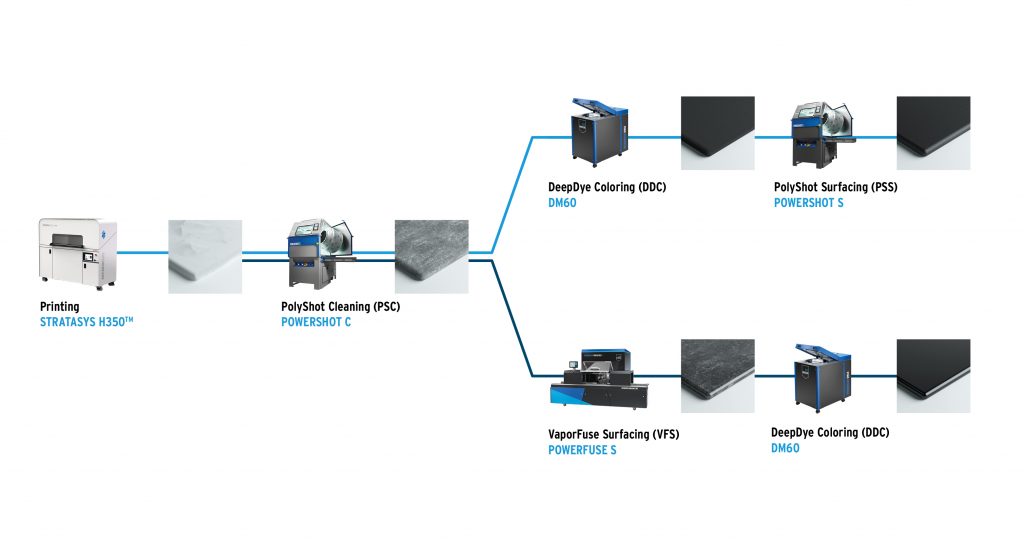The newly launched Stratasys H350 is the first additive manufacturing platform in the company’s H-series and is powered by selective absorption fusion (SAF). SAF is a polymer powder bed process that utilizes the High Speed Sintering 3D printing method developed by Xaar.
Post-processing specialist DyeMansion has now announced a strategic alliance with Stratasys. The collaboration results from joint efforts by the two companies to evaluate the use of DyeMansion’s Print-to-Product post-processing platform as a mass production solution within a 3D printing workflow.
Ahead of the launch, I caught up with Pat Carey, Stratasys Senior Vice President, Americas Products and Solutions, and Felix Ewald, CEO & Co-Founder, DyeMansion.

Building an end-to-end additive manufacturing workflow
The Print-to-Product workflow can be used with the H350 as a scalable method for cleaning, surfacing, and adding vibrant colors to otherwise dusty grey 3D prints. Currently, two finishes are available, “an aesthetic semi-gloss finish delivering a homogeneous scratch resistant surface, or a more functional finish delivering completely sealed and washable surfaces.”
Pat Carey tells me that applications are specifically expected in automotive, medical, and consumer product verticals. “Automotive is probably the biggest need for SAF right now in our view, but medical is really up there and also consumer products. They’re really fast followers,” he says.
“Together with DyeMansion, we’re giving our customers a comprehensive, proven additive manufacturing process tailored to our H350 3D printer. The alliance will help accelerate the adoption of SAF technology for end-use parts production,” says Carey.
Stratasys and the company’s service bureau operations, Stratasys Direct, have spent the better part of the last year using the new H350 3D printers. The wider SAF project has been under development for almost four years.
“We look at prosthetics, you look at eyewear, you look at finished parts in a car like vent covers and all that, we need to provide our customers with full solutions,” says Carey. It is for this reason DyeMansion and Stratasys are emphasizing “reference architecture.”
“When we apply our post-processing steps, the parts are really homogeneous; we are quite impressed with the bright colors we were able to achieve,” says Felix Ewald.
To demonstrate the quality possible, Carey shows me an electrical connector 3D printed on the H350. “We made 100,000 of these, and every pair connects. That’s about our focus on repeatability, says Carey. Regarding the actual number of individual parts possible in a print-run for this specific component, Carey shows me a snapshot of a build from the H350; it has 126 full connectors in it. “We can really fill the build envelope and have homogeneous parts,” says Carey. Ewald adds the complete build can then be processed in one go using DyeMansion machines.

Competing with injection molding and Industry 4.0
Turning back to the reference architecture, “We want to set up a reference architecture at Stratasys Direct manufacturing, says Ewald. This project will allow potential customers to understand the costs and workflow of using the H350 combined with DyeMansion post-processing. “We’re building that, and we’re going to start measuring as things go through how consistent it is, how much does it cost to dye, and how much does it cost to smooth,” says Carey. The initiative is intended to demonstrate the competitiveness of additive processes to potential users who may be focused on injection molding.
Naturally, any discussion of a scalable digital manufacturing workflow is not complete without reference to Industry 4.0. Carey’s past experience at Siemens, long-term proponents of digitalization benefits, positions him well to discuss this topic. “For us, it’s really important because as the printer gets more connected provides more data, the post-processing gets more connected and provides more data,” says Carey. “We need to plug into factories and interface with their data both ways.” Ewald adds, “It’s really also about traceability. How can you prove the process went well?” This element requires monitoring the processes and machine connectivity, specifically connecting to manufacturing execution systems (MES).
Characterization work is underway, and later this year, the reference architecture will be installed on-site at Stratasys Direct, where potential customers can attend workshops and factory tours.
Coupled with today’s announcement is the news that Stratasys channel partners will now be able to offer DyeMansion post-processing systems to customers. The Stratasys channel network is the largest in the 3D printing industry, and the ongoing adoption of industrial post-processing systems is another indication of the broader adoption of AM within the manufacturing world.

Attendees at this weeks AMUG Conference can learn more at a session tomorrow (Tuesday 4th May) where Tim Heller, commercial leader for H-Series products at Stratasys, and Michael Schorr, head of Application Consulting at DyeMansion North America, Inc., will discuss the reference architecture and show the first parts produced as part of the process.
Subscribe to the 3D Printing Industry newsletter for the latest news in additive manufacturing. You can also stay connected by following us on Twitter and liking us on Facebook.
Looking for a career in additive manufacturing? Visit 3D Printing Jobs for a selection of roles in the industry.
Featured image shows Stratasys H350 3D prints post-processed with DyeMansion systems. Photo via DyeMansion.



